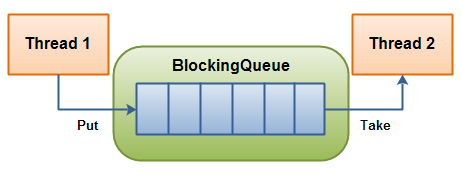1.阻塞队列的概念
阻塞队列与普通队列的区别在于,当队列是空的时,从队列中获取元素的操作将会被阻塞,或者当队列是满时,往队列里添加元素的操作会被阻塞。试图从空的阻塞队列中获取元素的线程将会被阻塞,直到其他的线程往空的队列插入新的元素。同样,试图往已满的阻塞队列中添加新元素的线程同样也会被阻塞,直到其他的线程使队列重新变得空闲起来,如从队列中移除一个或者多个元素,或者完全清空队列,下图展示了如何通过阻塞队列来合作:
线程1往阻塞队列中添加元素,而线程2从阻塞队列中移除元素
从刚才的描述可以看出,发生阻塞起码得满足下面至少一个条件: (前提:队列是有界的)
1.从队列里取元素时,如果队列为空,则代码一直等在这里(即阻塞),直到队列里有东西了,拿到元素了,后面的代码才能继续
2.向队列里放元素时,如果队列满了(即放不下更多元素),则代码也会卡住,直到队列里的东西被取走了(即:有空位可以放新元素了),后面的代码才能继续
下面先使用Object.wait()和Object.notify()、非阻塞队列实现生产者-消费者模式:
|
1
2
3
4
5
6
7
8
9
10
11
12
13
14
15
16
17
18
19
20
21
22
23
24
25
26
27
28
29
30
31
32
33
34
35
36
37
38
39
40
41
42
43
44
45
46
47
48
49
50
51
52
53
54
55
56
57
58
59
60
61
62
63
64
65
66
67
|
public
class
Test {
private
int
queueSize =
10
;
private
PriorityQueue<Integer> queue =
new
PriorityQueue<Integer>(queueSize);
public
static
void
main(String[] args) {
Test test =
new
Test();
Producer producer = test.
new
Producer();
Consumer consumer = test.
new
Consumer();
producer.start();
consumer.start();
}
class
Consumer
extends
Thread{
@Override
public
void
run() {
consume();
}
private
void
consume() {
while
(
true
){
synchronized
(queue) {
while
(queue.size() ==
0
){
try
{
System.out.println(
"队列空,等待数据"
);
queue.wait();
}
catch
(InterruptedException e) {
e.printStackTrace();
queue.notify();
}
}
queue.poll();
//每次移走队首元素
queue.notify();
System.out.println(
"从队列取走一个元素,队列剩余"
+queue.size()+
"个元素"
);
}
}
}
}
class
Producer
extends
Thread{
@Override
public
void
run() {
produce();
}
private
void
produce() {
while
(
true
){
synchronized
(queue) {
while
(queue.size() == queueSize){
try
{
System.out.println(
"队列满,等待有空余空间"
);
queue.wait();
}
catch
(InterruptedException e) {
e.printStackTrace();
queue.notify();
}
}
queue.offer(
1
);
//每次插入一个元素
queue.notify();
System.out.println(
"向队列取中插入一个元素,队列剩余空间:"
+(queueSize-queue.size()));
}
}
}
}
}
|
这个是经典的生产者-消费者模式,通过阻塞队列和Object.wait()和Object.notify()实现,wait()和notify()主要用来实现线程间通信。
具体的线程间通信方式(wait和notify的使用)在后续问章中会讲述到。
下面是使用阻塞队列实现的生产者-消费者模式:
|
1
2
3
4
5
6
7
8
9
10
11
12
13
14
15
16
17
18
19
20
21
22
23
24
25
26
27
28
29
30
31
32
33
34
35
36
37
38
39
40
41
42
43
44
45
46
47
48
49
50
51
|
public
class
Test {
private
int
queueSize =
10
;
private
ArrayBlockingQueue<Integer> queue =
new
ArrayBlockingQueue<Integer>(queueSize);
public
static
void
main(String[] args) {
Test test =
new
Test();
Producer producer = test.
new
Producer();
Consumer consumer = test.
new
Consumer();
producer.start();
consumer.start();
}
class
Consumer
extends
Thread{
@Override
public
void
run() {
consume();
}
private
void
consume() {
while
(
true
){
try
{
queue.take();
System.out.println(
"从队列取走一个元素,队列剩余"
+queue.size()+
"个元素"
);
}
catch
(InterruptedException e) {
e.printStackTrace();
}
}
}
}
class
Producer
extends
Thread{
@Override
public
void
run() {
produce();
}
private
void
produce() {
while
(
true
){
try
{
queue.put(
1
);
System.out.println(
"向队列取中插入一个元素,队列剩余空间:"
+(queueSize-queue.size()));
}
catch
(InterruptedException e) {
e.printStackTrace();
}
}
}
}
}
|
有没有发现,使用阻塞队列代码要简单得多,不需要再单独考虑同步和线程间通信的问题。
在并发编程中,一般推荐使用阻塞队列,这样实现可以尽量地避免程序出现意外的错误。
阻塞队列使用最经典的场景就是socket客户端数据的读取和解析,读取数据的线程不断将数据放入队列,然后解析线程不断从队列取数据解析。还有其他类似的场景,只要符合生产者-消费者模型的都可以使用阻塞队列。
3.实现原理:
这里只贴几段主要的代码,体会一下思想:
|
1
2
3
4
5
6
7
8
|
/** Main lock guarding all access */
final
ReentrantLock lock;
/** Condition for waiting takes */
private
final
Condition notEmpty;
/** Condition for waiting puts */
private
final
Condition notFull;
|
这3个变量很重要,ReentrantLock重入锁,notEmpty检查不为空的Condition 以及 notFull用来检查队列未满的Condition
Condition是一个接口,里面有二个重要的方法:
await() : Causes the current thread to wait until it is signalled or interrupted. 即阻塞当前线程,直到被通知(唤醒)或中断
singal(): Wakes up one waiting thread. 唤醒阻塞的线程
再来看put方法:(jdk 1.8)
|
1
2
3
4
5
6
7
8
9
10
11
12
|
public
void
put(E e)
throws
InterruptedException {
checkNotNull(e);
final
ReentrantLock lock =
this
.lock;
lock.lockInterruptibly();
try
{
while
(count == items.length)
notFull.await();
enqueue(e);
}
finally
{
lock.unlock();
}
}
|
1.先获取锁
2.然后用while循环检测元素个数是否等于items长度,如果相等,表示队列满了,调用notFull的await()方法阻塞线程
3.否则调用enqueue()方法添加元素
4.最后解锁
|
1
2
3
4
5
6
7
8
9
10
|
private
void
enqueue(E x) {
// assert lock.getHoldCount() == 1;
// assert items[putIndex] == null;
final
Object[] items =
this
.items;
items[putIndex] = x;
if
(++putIndex == items.length)
putIndex =
0
;
count++;
notEmpty.signal();
}
|
这是添加元素的代码(jdk 1.8),注意最后一行notEmpty.signal()方法,表示添加完元素后,调用singal()通知等待(从队列中取元素)的线程,队列不空(有值)啦,可以来取东西了。
类似的take()与dequeue()方法则相当于逆过程(注:同样都是jdk 1.8)
|
1
2
3
4
5
6
7
8
9
10
11
|
public
E take()
throws
InterruptedException {
final
ReentrantLock lock =
this
.lock;
lock.lockInterruptibly();
try
{
while
(count ==
0
)
notEmpty.await();
return
dequeue();
}
finally
{
lock.unlock();
}
}
|
类似的:
1. 先加锁
2. 如果元素个数为空,表示队列已空,调用notEmpty的await()阻塞线程,直接队列里又有新元素加入为止
3. 然后调用dequeue 从队列里删除元素
4. 解锁
dequeue方法:
|
1
2
3
4
5
6
7
8
9
10
11
12
13
14
15
|
private
E dequeue() {
// assert lock.getHoldCount() == 1;
// assert items[takeIndex] != null;
final
Object[] items =
this
.items;
@SuppressWarnings
(
"unchecked"
)
E x = (E) items[takeIndex];
items[takeIndex] =
null
;
if
(++takeIndex == items.length)
takeIndex =
0
;
count--;
if
(itrs !=
null
)
itrs.elementDequeued();
notFull.signal();
return
x;
}
|
倒数第2行,元素移除后,调用notFull.singnal唤醒等待(向队列添加元素的)线程,队列有空位了,可以向里面添加元素了。























 394
394

 被折叠的 条评论
为什么被折叠?
被折叠的 条评论
为什么被折叠?








